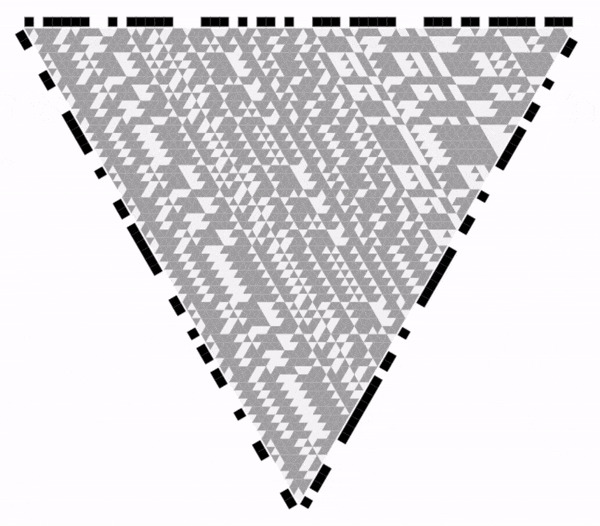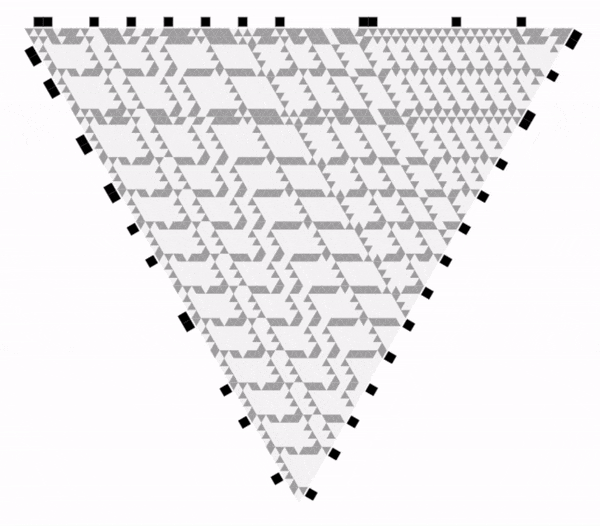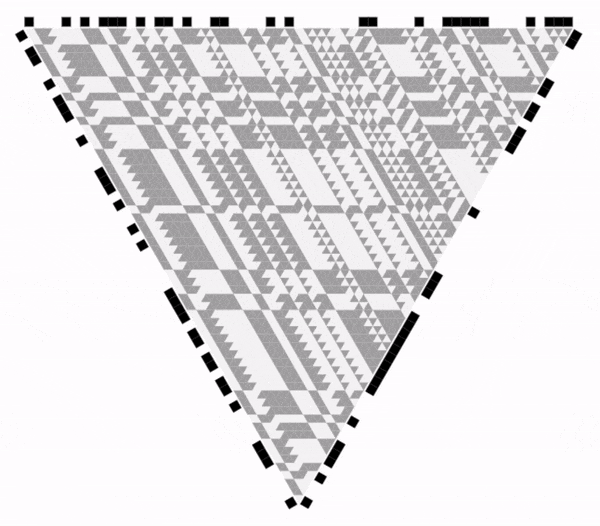
Many physicists believe that the three-dimensional space we inhabit may be a hologram (projection) produced by entanglement on a lower-dimensional (e.g. two-dimensional space). On this account, three-dimensional space is reliable and generally obeys locality because the mapping from a two-dimensional boundary (where? nobody knows!) to our three-dimensional world is an error-correcting code that is robust to small changes in the entanglement structure on the boundary.
Inspired by this, I hoped to produce a holographic error-correcting-code with a cellular automata running on the lower-dimensional part of the hologram (the “boundary”) and its projection appearing in the higher-dimension (the “bulk”, in the language of holographic duality).
I tried to reproduce the pentagonal error-correcting code described in this paper, but I couldn’t figure out how to construct the pentagonal lattice.

Instead, I ended up creating a triangular lattice where a 1D elementary cellular automaton runs on the boundary of the triangle and the same cellular automaton projects values from the boundary onto the interior of the triangle.
In this construction, each triangle in the interior is matched with a unique triplet of cells on the boundary, one from each side (see diagram):

This construction can take any elementary cellular automaton. Here’s what it looks like with Rule 110:



With more time, I’d like to build a true error-correcting code where the values on the boundary propagate inwards gradually and in the process mix with each other.
This project started as a grid showing a pattern for each side of a die. But I thought I would add some text to the screen to ascertain if you dialed a “2” or “5”. After that, I decided to make further changes to make it stand out more. At this point, I decided to randomly generate the six kingdoms of life with the help of the pattern template I also ready-made.
Here is a link to the project: Which Kingdom are You?
Pictured: Planning the six kingdoms of life with the same pattern as the die.


I went fully analog this week :)
And made like a tic tac tarot.
Based on the result of a tic tac toe game I will give you a word and a color palette that represents a feeling.


For this week, I wanted to try to create a CA using p5.js. I tried to implement a simple 1-D Automaton.
However, instead of the basic binary rules, I wanted to do a play on shades.
The basic idea was still focusing on a neighborhood of 3.
So,
Let L be fill value of left cell.
Let R be fill value of right cell
Let M be fill value of current cell
But the rules I used were as follows:
```bash If (L+R < 255) { Then { If (L+R > M) then M=( L+ R); Else if (L+R < M)
then M = L and R with equal probability.
On the other hand, If (L+R > 255) {
If (L+R >M) then M = (abs(L-R)); Else { M = M; } ```
This has been my first time trying to code this in P5. js. So unfortunately, the code isnt working yet. But my hope is it will work and am exciting to add my results here.
